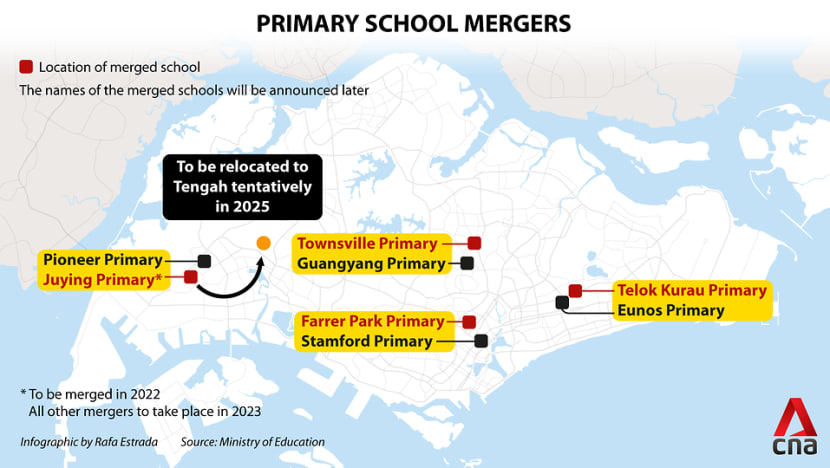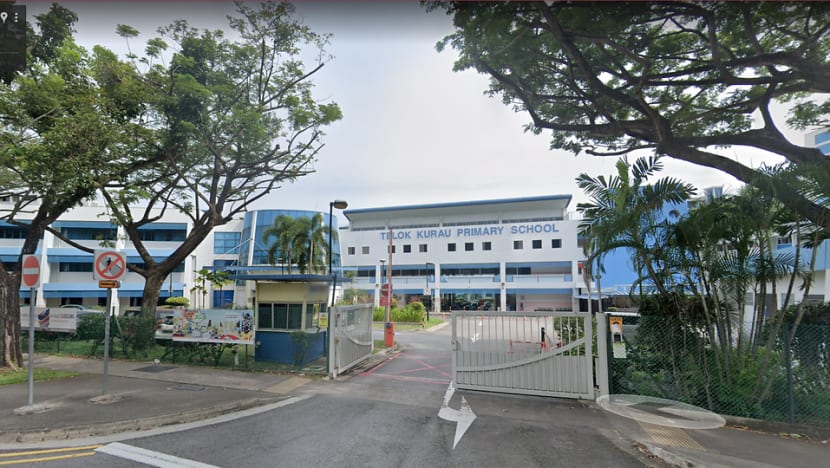commentary Commentary
Commentary: Grappling with the sadness and outrage triggered by school mergers
Getting over the change for school alumni can be hard. But the biggest challenge may be for kids studying in those schools when they move, says June Yong.

Stamford Primary School, which was founded in 1951, is one of the 18 schools affected by this round of mergers. (Photo: Google Street View)
SINGAPORE: The Ministry of Education (MOE) announced last week that four pairs of primary schools and five pairs of secondary schools in Singapore will be merged between 2022 and 2024.
This is the third round of school closures in the last five years. In 2016, there were plans to merge 22 secondary schools. In 2017, MOE also announced the merger of 28 schools, including four pairs of junior colleges.
The main reason behind the slate of closures? Falling birth rates and alongside it, shrinking school cohorts.
READ: Commentary: The cult of work is eroding the value of parenthood
SENTIMENTALITY OVER SCHOOL CLOSURES
School closures – we have seen this happen time and time again. They are a stern admonition of our lack of procreation, despite gentle, constant reminders.
Their shuttering is a manifestation that what we are sacrificing lies not only in the years ahead but also in the past, with the precious places of youth providing many a cherished memory the price we pay.
In one fell swoop, because we’re not making the present decision to have more children, both our past and the future must be punished.
We know this is our burden to bear. It is unsurprising therefore that the first response when hearing such news tends to be sadness, or even outrage, especially if one has links to these schools.
Sometimes, it can seem like some schools are bearing the brunt more than others, when netizens have asked why the neighbourhoods schools seem to be getting the short end of the stick more often in each round of closures.
We would be hard-pressed to find the same fate befalling popular schools like CHIJ St Nicholas Girls School despite its location in a mature estate.

Then again, with prestigious primary schools seeing no lack of eager parents volunteering each year in the hopes of enrolling their kids there, perhaps the answer is clearer than we realise.
Our pursuit of brand-name schools have created an endless stock of students flocking to them, even when this sometimes involves traveling long distances each day.
Still, sympathetic Singaporeans can’t help but want to rescue our neighbourhood alma maters. And so many have questioned why the schools cannot simply adopt smaller class sizes and continue running as they are.
But schools, it seems, are also subject to the dynamics of supply and demand. Would parents be willing to pay higher school fees for teachers to continue earning their current wages despite class sizes shrinking?
READ: Commentary: The struggle parents face in picking a 'good school' for their child
READ: Commentary: Look beyond state-of-the-art campuses for what matters in education
We are practical people at the end of the day. The Ministry has said that most schools must still attain a certain economy of scale, in order to sustain the quality and variety of its programmes, such as co-curricular activities for the children.
Other observers have suggested moving the school to newer housing estates (with a higher proportion of young families) to “preserve the heritage”, but this may turn out to be impractical as many families opt for their kids to attend schools close to their homes.
It’s understandable when so many of our formative years were spent in schools. There is a sense of history associated with the school grounds that you’ve roamed about, played zero-point on, and received your first major examination results.
For some, there is a strong sense of identity, of camaraderie, as “old girls and boys”. Although we are all grown up now, many of us retain fond memories of our first favourite teachers and principals. Especially those who played a formative role in our character training and upbringing.
READ: Commentary: Primary School registration has gone online and is more straightforward. So why is it still stressful?
On the other hand, is it a little over the top to be sentimental about a place where we’ve barely stepped foot in for the past two decades? How many of us have contributed back or participated in alumni events?
When it comes to emotions, there is often no straight answer.
In visiting a childhood stomping ground, we can feel an overwhelming sense of nostalgia.

The memories come flooding back at an old school – be it of a principal telling us to quit hiking our skirts up as we run past her in the concourse, or the drinks stall aunty who used to sell “mixed” – drinks made of coke, 7-up and who knows what else went into that concoction.
Perhaps part of the reason we get worked up is because we did not have the chance to properly say goodbye, when PSLE or O-levels happened so fast, we were out of school before we had the chance to process that farewell.
READ: Commentary: Learning to let go as a parent of a Primary 1 child
So for schools with a longer history, school leaders might consider arranging a virtual closing off ceremony each year for alumni and school parents to express their appreciation for the school leaders and gain closure for themselves.
Or invite past students and staff to contribute photos and yearbooks to be placed in the newly merged school’s premises.
Perhaps the side-gate, an old chair or an iconic wall mural could be saved, accompanied by an inscription to commemorate that token of those days of yore in the newly merged school. A time capsule can preserve a prized moment in time for us all, even if the school compound has to go.
As a country, we’re great at tearing places down and placing new developments where they used to stand, less so with retaining a piece of yesterday’s history for tomorrow’s memory.
What might appear to be a small gesture can bear a deep significance – especially if it helps children and parents build a sense of ownership and appreciation of deep roots in the new school entity.
(Listen to three working adults reveal how their PSLE results have shaped their life journeys in a no-holds barred conversation on CNA's Heart of the Matter podcast:)
UPHEAVAL OF ROUTINES
The bigger impact may be on the kids still in the school when it has to merge and move.
Speaking as a parent whose child has seen her school St Margaret’s Primary shift to a temporary site some distance away, while major upgrading works are carried out, I recall how parents were concerned of adjustments to a new environment and the longer travel distance.
It can be difficult for our children to suddenly have to uproot from the school that they’ve been attending for some time, especially if they are in the more crucial exam preparation years of Primary Six or Secondary Four.
If there are at-risk children in the mix, the picture is even more complex.
As parents, we work tirelessly in the early years to instill a sense of structure and routine in our children’s lives. This helps create a sense of stability and security.
READ: Commentary: Your PE teacher’s secret headaches during a year of COVID-19
READ: Commentary: After the craziest year, teachers start first day of school with nervous apprehension
While we all know that change is uncomfortable, we can cultivate a positive attitude towards it in the way we communicate with our children. Children tend to be more adaptable than we think.
In all likelihood, they will settle into the new compound just as quickly as they settled into Primary One. They will learn to navigate the new classrooms and facilities in a jiffy, and even if there are challenges, they will at least be able to find solace in the same friends who have moved along with them.
And for all the alumni mourning the mergers of their schools, perhaps an educational moment lies in these questions: What happened to the relationships we've made, the people around us, the teachers, and the friends?
Have we become concerned with the replacement of a physical building, the loss of a named institution, at the expense of forgetting what remains of our time there in the ties we’ve let lapse?
It’s not a case of either/or but my hope is that we see the newopportunity in these school closures to open up freshconversations with old friends.
June Yong is a mother of three, an educational therapist and owner of Mama Wear Papa Shirt, a blog that discusses parenting and education in Singapore.












